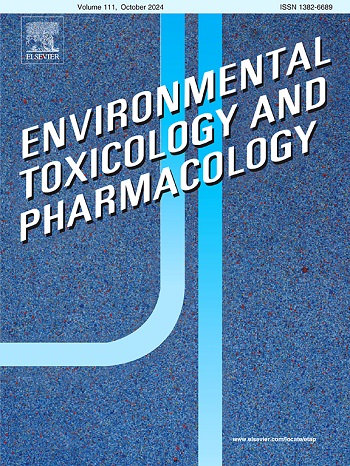Toxicity of ametryn and clomazone in zebrafish: Environmentally relevant concentrations induce developmental and enzymatic alterations
IF 4.2
3区 环境科学与生态学
Q2 ENVIRONMENTAL SCIENCES
引用次数: 0
Abstract
Ametryn (AMT) and clomazone (CLZ) are widely used for weed control, often in combination. This study evaluated the effects of environmentally relevant concentrations of AMT, CLZ, and their mixtures on zebrafish embryonic-larval development and enzyme activity. Exposure to AMT (≥0.1 µg/L) and CLZ (≥36 µg/L) significantly reduced swim bladder inflation, although their mixture showed an antagonistic effect, minimizing damage. Both herbicides reduced acetylcholinesterase (AChE) activity, an effect observed from the lowest concentrations tested, indicating neurotoxicity, while the mixture mitigated this effect. Aspartate aminotransferase (AST) activity increased from 6 µg/L AMT and 20 µg/L CLZ, and alanine aminotransferase (ALT) activity increased from 3.7 µg/L AMT and 6 µg/L CLZ, suggesting hepatotoxicity. Alkaline phosphatase (ALP) activity increased with 3.7 µg/L AMT and 6 µg/L CLZ. The mixture modulated enzyme alterations and increased damage at specific concentrations. Overall, AMT and CLZ exposure impaired development and altered enzyme function, causing neurotoxic and hepatotoxic effects.
阿米丁和氯马酮对斑马鱼的毒性:环境相关浓度诱导发育和酶的改变。
艾美汀(AMT)和氯马唑酮(CLZ)被广泛用于杂草控制,通常是联合使用。本研究评估了环境相关浓度的AMT、CLZ及其混合物对斑马鱼胚胎-幼虫发育和酶活性的影响。暴露于AMT(≥0.1µg/L)和CLZ(≥36µg/L)可显著减少鱼鳔膨胀,尽管它们的混合物显示出拮抗作用,使损伤最小化。两种除草剂都降低了乙酰胆碱酯酶(AChE)的活性,这一效应从最低浓度的测试中观察到,表明神经毒性,而混合物减轻了这种作用。谷草转氨酶(AST)活性从6µg/L AMT和20µg/L CLZ升高,丙氨酸转氨酶(ALT)活性从3.7µg/L AMT和6µg/L CLZ升高,提示肝毒性。3.7µg/L AMT和6µg/L CLZ使碱性磷酸酶(ALP)活性升高。这种混合物调节了酶的变化,并在特定浓度下增加了损伤。总的来说,AMT和CLZ暴露会损害发育并改变酶功能,导致神经毒性和肝毒性作用。
本文章由计算机程序翻译,如有差异,请以英文原文为准。
求助全文
约1分钟内获得全文
求助全文
来源期刊
CiteScore
7.00
自引率
4.70%
发文量
185
审稿时长
34 days
期刊介绍:
Environmental Toxicology and Pharmacology publishes the results of studies concerning toxic and pharmacological effects of (human and veterinary) drugs and of environmental contaminants in animals and man.
Areas of special interest are: molecular mechanisms of toxicity, biotransformation and toxicokinetics (including toxicokinetic modelling), molecular, biochemical and physiological mechanisms explaining differences in sensitivity between species and individuals, the characterisation of pathophysiological models and mechanisms involved in the development of effects and the identification of biological markers that can be used to study exposure and effects in man and animals.
In addition to full length papers, short communications, full-length reviews and mini-reviews, Environmental Toxicology and Pharmacology will publish in depth assessments of special problem areas. The latter publications may exceed the length of a full length paper three to fourfold. A basic requirement is that the assessments are made under the auspices of international groups of leading experts in the fields concerned. The information examined may either consist of data that were already published, or of new data that were obtained within the framework of collaborative research programmes. Provision is also made for the acceptance of minireviews on (classes of) compounds, toxicities or mechanisms, debating recent advances in rapidly developing fields that fall within the scope of the journal.

 求助内容:
求助内容: 应助结果提醒方式:
应助结果提醒方式:


